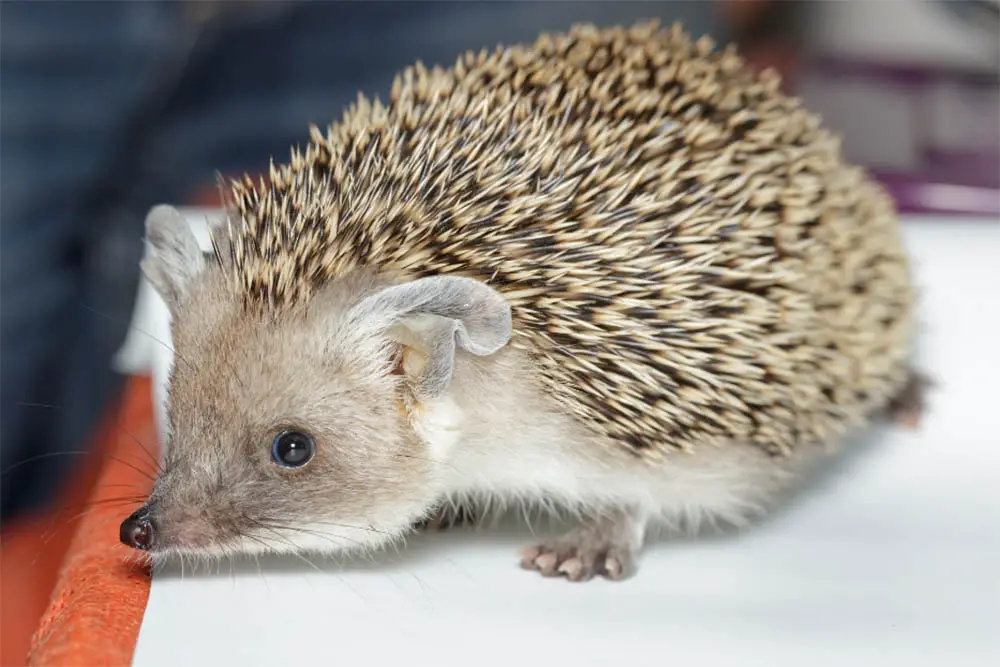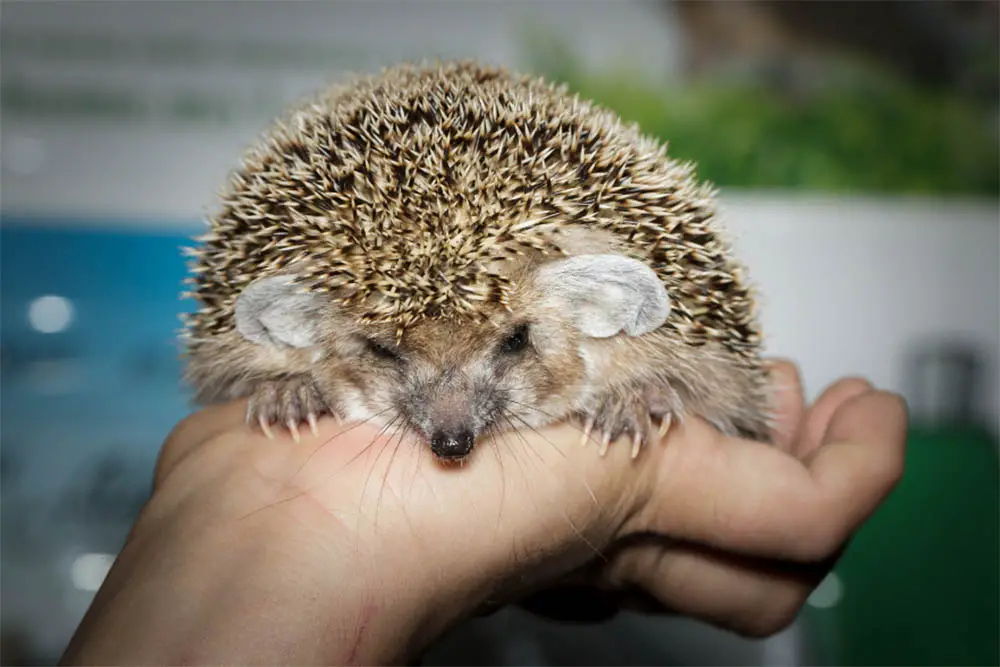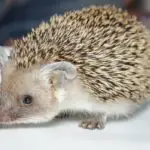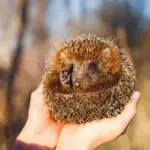A small hedgehog with some very striking physical features, the Indian Long-Eared Hedgehog is a commonly domesticated hedgehog species, although there is less information available surrounding this type of hedgehog than some of its counterparts.

We’ve done our research and collated the ultimate guide to Indian Long-Eared Hedgehogs, including information on taxonomy, diet, health, behavior, and legal considerations for ownership.
By the time you’ve finished this article, you’ll be an Indian Long-Eared Hedgehog Expert and potentially a well-prepared hedgehog owner!
Taxonomy
The Indian Long-Eared Hedgehog can also be referred to by its scientific name, which is Hemiechinus Collaris.
As indicated by its scientific name, the Indian Long-Eared Hedgehog is a member of the Hemiechinus genus. This genus only comprises 2 hedgehog species, including the Indian Long-Eared Hedgehog, both of which are native to South and Central Asia.
The other species encompassed by the Hemiechinus genus, if you were wondering, is the Long-Eared Hedgehog (Hemiechinus Auritus).
Hemiechinus Collaris is part of the Erinaceidae family. This family is dedicated to small mammals such as hedgehogs and gymnures. Gymnures are also sometimes called moonrats and resemble hedgehogs with hair instead of spines.
Of course, since the Erinaceidae family is comprised of small mammals, it’s no surprise that the Indian Long-Eared Hedgehog is of the class Mammalia, which is used to refer to all mammals (vertebrate animals with mammary glands).
The Indian Long-Eared Hedgehog is distinguished from other mammals, however, by its Order: Eulypotyphla, which translates to ‘truly fat and blind.’ In addition to hedgehogs and gymnures, the Eulypotyphla order is also home to moles and shrews.
Conservation Status
We are pleased to inform you that the Indian Long-Eared Hedgehog is not a threatened species when it comes to extinction.
In fact, the Indian Long-Eared Hedgehog is listed as a species of least concern on the conservation spectrum. This is the best possible ranking, at the opposite end of the spectrum from ‘extinct.’
Therefore, while there are some very valid concerns surrounding the importation and keeping of wild animals such as hedgehogs, which we’ll get into in more detail shortly, the conservation status of the Indian Long-Eared Hedgehog is not one of them.
Identifying Features
The Indian Long-Eared Hedgehog is relatively easy to identify, especially when directly compared to other hedgehog species.
One of the first features that distinguish the Indian Long-Eared Hedgehog from the rest of the hedgehog family is its size. Compared to other hedgehogs, Hemiechinus Collaris is fairly small, usually only growing up to 17 cm (6.69 inches) in length.

Depending on how well-fed and how mature an individual Indian Long-Eared Hedgehog is, this hedgehog species can weigh anywhere between 200 and 500 grams.
While the Indian Long-Eared Hedgehog might be small overall, its facial features are proportionally large. This hedgehog’s ears and eyes are sizeable to help it to navigate deserts at night (Indian Long-Eared Hedgehogs are nocturnal).
The Indian Long-Eared Hedgehog also has long whiskers around its snout. Because Hemiechinus Collaris mostly feeds on insects (more on the Indian Long-Eared Hedgehog’s diet below), it needs its sense of smell to effectively locate prey in sandy terrain.
Diet
For the most part, the Indian Long-Eared Hedgehog gets its nutritional needs met in the form of desert-dwelling insects.
Because the Indian Long-Eared Hedgehog is small in comparison to other hedgehogs, its diet is usually limited to smaller insects such as beetles, worms, earwigs, and millipedes.
While most other hedgehog species rely heavily on drinking water for hydration, Indian Long-Eared Hedgehogs have adapted to source most of their water from the insects that they consume.
Health
Indian Long-Eared Hedgehogs have evolved to be very hardy little animals.
The temperatures in South and Central Asian desert climates plummet at nighttime when these nocturnal hedgehogs do most of their hunting and mating. In the daytime, when the Indian Long-Eared Hedgehog burrows underground to sleep, these deserts can reach incredibly high temperatures.
Because these hedgehogs don’t have easy access to water, they can survive in extreme conditions and under difficult circumstances. They even have the ability to lower their metabolisms to cope in the absence of food.
However, despite being physically tough, the Indian Long-Eared Hedgehog is a known carrier of parasites and zoonotic diseases.
Some of these parasites are internal, such as worms, and can cause digestive issues in the hedgehog.
Others are external, such as ticks, mites, and fleas. These parasites not only cause dermatological problems in the hedgehog but can also spread to other hedgehogs, animals, and humans.
Hedgehogs may also carry bacteria such as salmonella, which might not noticeably affect the health of the hedgehog, but can certainly be very dangerous for the humans that they may interact with.
Therefore, when considering the health status of the Indian Long-Eared Hedgehog, it’s also important to be aware of the types of diseases hedgehogs carry that could impact human beings or other animals.
Behavioral Traits
As we have mentioned a couple of times in this article, Indian Long-Eared Hedgehogs are nocturnal. This means that they are active at night and usually sleep during daylight hours. Therefore, you will not often see an Indian Long-Eared Hedgehog hunting or mating during the day.
Speaking of mating, Indian Long-Eared Hedgehogs breed during the summer months. Specifically, the breeding season for females is between April and August, while the males of the species have an extra month-long window, spanning March to August.
One particularly interesting behavior observed in Indian Long-Eared Hedgehogs is their mating ritual, which involves the male performing quite an elaborate dance around the female for a few days before breeding.
Legality of Ownership
Because hedgehogs are not native to the United States, the Indian Long-Eared Hedgehog is classified as an exotic animal. As a result, ownership of any type of hedgehog (including the Indian Long-Eared species) is banned across multiple US states.

Therefore, before you start planning your new life as a hedgehog owner, you’ll need to verify whether ownership of a pet hedgehog is legal in your state.
States that have banned the ownership of hedgehogs include Washington D.C., New York, Nebraska, Omaha, Georgia, Pennsylvania, California, and Hawaii. If you reside in any of these states, then you will not be able to legally own
If you live in Wisconsin or New Jersey, you can legally own a hedgehog, but you might need to get a permit in order to do so. This permit will only be issued if your living conditions meet certain standards set out in your state’s wildlife possession legislation.
Please bear in mind that even if you live in a state that doesn’t impose strict regulations on hedgehog ownership, you will still have to abide by certain laws surrounding the importation of your new hedgehog friend.
For example, in all states in the US, it is illegal to have a hedgehog imported from Africa.
Now, since the Indian Long-Eared Hedgehog is not native to Africa, this shouldn’t be too much of an obstacle. However, it’s still worth bearing this in mind in the event that you come across an Indian Long-Eared Hedgehog breeder based in Africa.
Should you import an Indian Long-Eared Hedgehog from Africa into the U.S. or home an Indian Long-Eared Hedgehog in a state where hedgehog ownership is banned, you could find yourself on the receiving end of a fine.
This is because importation and exportation offenses fall under the category of wildlife trafficking.
Even if you have had no direct involvement with the importation process, you can still be charged with illegal possession or acquisition.
The penalty for illegal importation or possession of wildlife usually constitutes a fine, although a term of imprisonment can be considered depending on the extent of the offense.
For instance, if the offense is coupled with proof of animal cruelty or previous wildlife-related offenses, the court may decide that imprisonment is a more appropriate penalty.
Additionally, some of the common health problems (see above) that afflict the Indian Long-Eared Hedgehog make the purchasing process a little more complicated than it typically is for other species.
Since Indian Long-Eared Hedgehogs, like the majority of long-eared hedgehogs, are prone to parasitic infections, you will need to make sure that you buy your hedgehog from a reputable and conscientious breeder who will ensure that the hedgehog is healthy and parasite-free.
Moreover, due to the fact that Indian Long-Eared Hedgehogs are potential zoonotic disease carriers, they are covered under the CDC’s 42CFR71.54 regulation.
This regulation stipulates that small mammals that are known to carry zoonotic diseases can only be imported into the United States with a permit issued by the District Director of U.S. customs. Therefore, you will need to obtain this permit if your Indian Long-Eared Hedgehog is being imported from outside the U.S.
Care Guidelines
Now that you clearly understand the legal implications of purchasing and owning an Indian Long-Eared hedgehog, you are in a position to make an informed decision about whether or not to bring this species of hedgehog home.
If you are legally able to own an Indian Long-Eared Hedgehog in your state and feel capable of providing this animal with the best quality of life, it’s time to think about how to create an optimal living environment for your pet.
We’ve already discussed some of the key aspects of hedgehog care in terms of dietary information, behaviors, and health, but in this section, we’ll be building on the information we provided above to outline how to actively care for an Indian Long-Eared Hedgehog.
Indian Long-Eared Hedgehog Enclosures
Before you prepare anything else, you will need to make sure that your Indian Long-Eared Hedgehog has a comfortable and appropriate enclosure to live in.
Unlike domesticated cats and dogs, hedgehogs are still very much adapted to live in the wild. Indian Long-Eared Hedgehogs, in particular, are used to roaming deserts in extreme temperatures.
Therefore, an indoor enclosure will not be good for your hedgehog’s physical or mental health. Instead, you should keep your hedgehog in a cage, crate, or another type of enclosure outside your home.
The only time when you might need to bring your hedgehog indoors is if it becomes severely underweight during the winter months, in which case it may not be able to protect itself against nighttime temperatures.
Again, however, Indian Long-Eared Hedgehogs are more resilient against the cold than most hedgehog species, so this should not be a problem unless you are not feeding your hedgehog adequately or the hedgehog has an underlying health condition.
You will also need to ensure that your Indian Long-Eared Hedgehog’s enclosure has enough space to move around. As we’ve mentioned, this hedgehog species is particularly hardy and active due to the intense conditions of its natural habitat, so a small enclosure can be a detrimental environment for an Indian Long-Eared Hedgehog.
The cage or crate that you choose for your Indian Long-Eared hedgehog should measure at least 8 square feet, although we would honestly recommend going as large as possible if you want your hedgehog to be truly happy.
Remember, it is in the Indian Long-Eared Hedgehog’s nature to wander around huge areas of desert in search of food, so you should aim to provide as much room to move as possible.
If you don’t have enough space for an extra-large cage or crate, we recommend having an exercise wheel installed in the enclosure so that your hedgehog can get enough exercise.
Please do not keep your Indian Long-Eared Hedgehog in a wire cage. Although these hedgehogs have big ears and eyes, their feet are very small, making it easy for them to slip through wire bars.
This can result in your hedgehog becoming stuck or injured. If possible, try to find a smooth-sided enclosure with a flat floor and high walls.
Feeding Your Indian Long-Eared Hedgehog
As mentioned previously, the Indian Long-Eared Hedgehog’s diet is primarily made up of insects due to their nutritional and hydrating benefits.
Therefore, the best food source for Indian Long-Eared Hedgehogs is a blend of fresh insects.
You can also find specialist hedgehog food through certain pet stores and online retailers, although you’ll need to ensure that it is suitable specifically for Indian Long-Eared Hedgehogs.
Moreover, you’ll need to think carefully about the water content of any food that you give to your Indian Long-Eared Hedgehog. As we mentioned earlier, in the wild, the Indian Long-Eared Hedgehog gets most of its hydration from the water content of insects.
If you are feeding your Indian Long-Eared Hedgehog anything other than non-dried insects, you’ll probably need to supplement its diet with an accessible bowl of water.
Frequently Asked Questions
Is it ethical to have a pet Indian Long-Eared Hedgehog?
This is a pretty controversial question, and you’ll get different answers depending on who you ask.
The keeping of hedgehogs in general, regardless of the species, has been hotly contested by animal rights groups such as PETA in recent years, given the increasing popularity of the hedgehog as a wild or exotic pet.
The main concerns surrounding domestic hedgehog ownership are space and climate.
Hedgehogs imported from other countries may struggle to adapt to new temperatures. Being kept in an enclosure is also unnatural for hedgehogs, who normally walk several miles per day in the wild.
There is also the issue of the rising popularity of hedgehogs on the pet market, which means that breeders are struggling to meet demands. As a result, some breeders push female hedgehogs past their limits in terms of producing litters.
In the wild, Indian Long-Eared Hedgehogs are used to dramatic changes in temperature and can handle both extreme cold and warmth, so the difference in climate is typically less of an issue.
However, the lack of space can certainly be a problem on both a physical and mental level. Without enough exercise, hedgehogs can become obese, and the frustration of being kept in a small enclosure can reflect in the hedgehog’s temperament.
If you choose to keep an Indian Long-Eared Hedgehog as a pet, please do thorough research into the best breeders and ensure that you can provide enough space for your hedgehog to live a happy life.
Final Thoughts
The Indian Long-Eared Hedgehog might be one of the most commonly domesticated hedgehog species in the world, but taking one on is a huge decision and a big ethical responsibility.
Keeping an Indian Long-Eared Hedgehog as a pet is not legal in all U.S. states, so please do your due diligence prior to purchasing a hedgehog and check the wildlife laws in your state of residence.
Indian Long-Eared Hedgehogs eat insects, are active at night, and breed throughout the summer months.
Remember, Indian Long-Eared Hedgehogs are energetic and tough little mammals, so they need lots of exercise and space to explore.
While they may appear externally healthy due to their resistance to inhospitable environments, owners should be aware of the potential for parasitic infections and zoonotic disease.
Thank you for reading, and we wish you the best of luck with your future hedgehog-keeping or studying endeavors!









